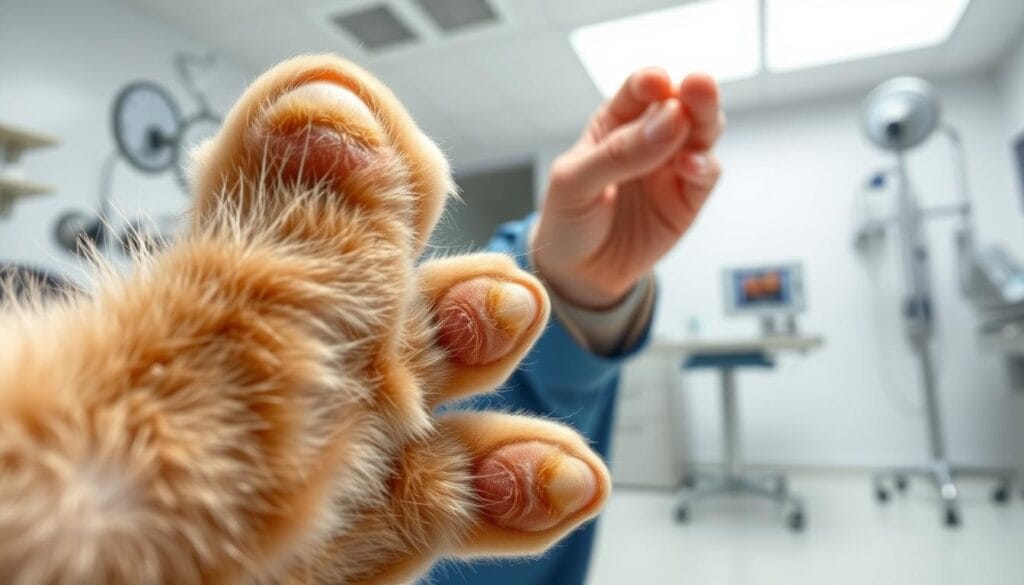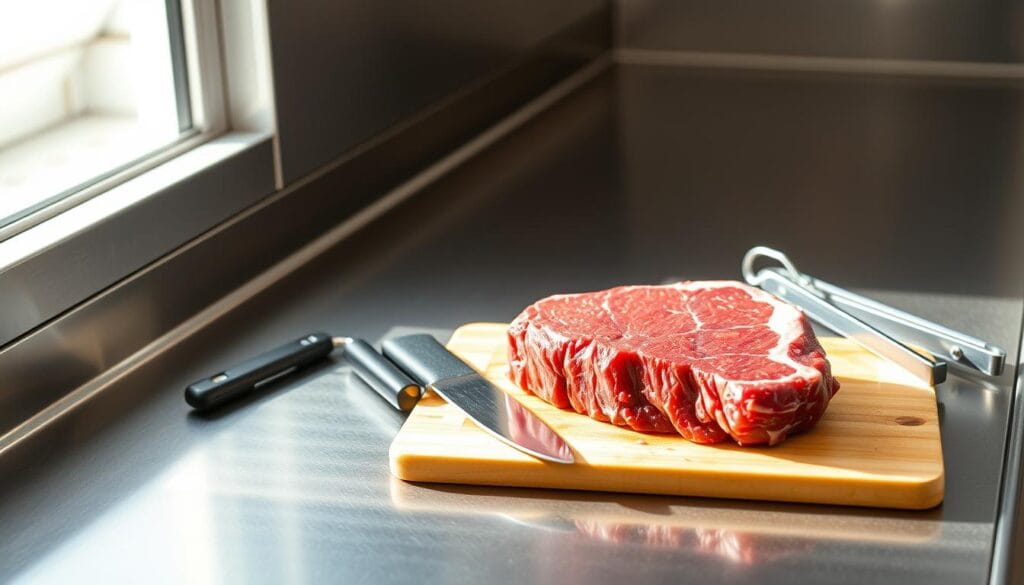Can Cats Eat Raw Meat or Chicken Safely?
Every pet owner wants the best for their furry companion. The question of what to feed them often sparks passionate debates, especially when it comes to natural diets. Raw feeding has gained attention as a way to mirror a wild ancestor’s meals, but is it truly safe?
Table of Contents
This topic divides veterinarians and animal lovers alike. While some praise raw diets for potential benefits like shinier coats, others warn about bacterial risks and nutritional imbalances. Consulting a trusted veterinarian remains critical before altering your pet’s food routine.
Balanced nutrition is non-negotiable for feline well-being. Poorly planned meals might lead to deficiencies or digestive issues. Proper handling of uncooked ingredients also minimizes exposure to harmful pathogens that could affect both pets and humans.
Understanding the science behind dietary choices empowers responsible decisions. This guide explores the complexities of raw feeding, offering clarity on hygiene practices and meal preparation. Let’s prioritize your companion’s long-term health while navigating this controversial yet intriguing approach.
Understanding Raw Diets for Cats
Exploring feline nutrition reveals diverse feeding philosophies, with raw diets sparking curiosity and caution. These meal plans aim to replicate ancestral eating patterns but require careful planning to meet modern health standards.
What Is a Raw Food Diet?
A raw food diet typically includes uncooked muscle meat, organs, and bones. Some recipes incorporate vegetables or supplements to mimic natural prey. Commercial cat food labeled “complete” meets all nutritional needs, while “complementary” options require pairing with other diets.
Homemade Versus Commercial Options
Pre-packaged raw diet products undergo quality testing for balanced nutrients. Homemade versions often lack consistency in ingredients, risking deficiencies without veterinary guidance. Shelf-stable freeze-dried formats offer convenience but differ from fresh preparations.
Key differences between approaches include:
- Commercial blends: Standardized nutrient profiles
- Homemade meals: Flexibility but higher error risk
- Storage needs: Frozen vs. fresh preparation
Understanding these fundamentals helps owners evaluate if uncooked food diets align with their pet’s needs. Always prioritize safety and scientific backing when exploring alternative cat food strategies.
can cats eat raw meat: Benefits, Risks, and Veterinary Insights
Modern feline meals spark debates between ancestral habits and today’s health standards. While some praise uncooked diets as “biologically appropriate,” others highlight gaps between wild instincts and domestic needs.

Historical Context vs Current Practices
Wild felines hunt prey containing bones, organs, and muscle meat. Domestic companions, however, face fewer parasites and live longer than their outdoor relatives. Evolutionary changes mean their digestive systems differ from wild counterparts.
| Aspect | Historical Context | Current Practices |
|---|---|---|
| Diet Composition | Whole prey, seasonal variations | Controlled recipes, supplements |
| Health Risks | Natural pathogens | Foodborne illness concerns |
| Nutritional Knowledge | Instinct-driven intake | Science-backed formulations |
Analyzing Veterinary Opinions
Most veterinarians caution against homemade raw plans due to bacterial risks like Salmonella. Studies show cooked proteins provide equal nutrition without pathogen exposure. Commercial frozen diets reduce but don’t eliminate contamination risks.
Regular check-ups help monitor nutrient absorption if owners pursue raw feeding. Professional guidance ensures meals meet AAFCO standards for complete feline nutrition. Always prioritize safety over trends when choosing your companion’s meals.
Benefits of a Raw Diet for Your Feline Friend
Exploring alternative feeding strategies reveals potential advantages for pets with specific needs. While not universally recommended, some animals thrive on carefully balanced uncooked meals when supervised by professionals.
Improved Digestion & Skin Health
Many owners notice fewer digestive upsets after switching to unprocessed meals. High-quality protein sources and natural enzymes in fresh ingredients often lead to smoother nutrient absorption. This can reduce stool volume and odor, making litter box maintenance easier.
Essential fatty acids in uncooked diets support skin elasticity and coat shine. Animals prone to allergies may experience fewer flare-ups due to the absence of artificial additives common in processed foods.
Weight Management and Enhanced Energy
Moisture-rich meals promote hydration and satiety, helping pets feel fuller longer. Unlike carb-heavy options, protein-focused nutrition provides steady energy without blood sugar spikes. This approach often aligns better with natural metabolic rhythms.
Active companions may show increased vitality, as bioavailable nutrients require less energy to break down. Regular monitoring ensures portion sizes meet individual health requirements while preventing overfeeding.
Risks and Safety Concerns When Feeding Raw Meat
Feeding uncooked ingredients to pets involves critical safety considerations that demand attention. While some owners advocate for natural meal plans, potential dangers lurk in improperly handled proteins. Understanding these hazards helps protect both animals and households from preventable health issues.

Bacterial Contamination and Food Poisoning
Uncooked proteins often harbor harmful pathogens like Salmonella and E. coli. These bacteria pose risks not only to pets but also to humans through cross-contamination. Home-prepared fish, for instance, may contain parasites that commercial processes eliminate through freezing.
Raw pork and chicken carry additional threats, including parasites like Toxoplasma. Even fresh ingredients without seasoning can become dangerous if stored improperly. Always use separate utensils and surfaces when handling these foods to minimize exposure.
Bone Hazards and Nutritional Imbalances
While raw bones provide calcium, cooked varieties splinter easily and cause internal injuries. Size matters—small bones may choke, while large ones damage teeth. Proper selection ensures safety during chewing.
Nutritional gaps emerge when meals lack organ meats or essential supplements. Diets missing taurine or balanced calcium-phosphorus ratios jeopardize long-term health. Consult a veterinarian to create meals meeting all dietary requirements.
| Safe Practices | Risky Choices |
|---|---|
| Raw, meaty bones | Cooked poultry bones |
| Freezing fish for 48+ hours | Unprocessed raw fish |
| Commercial supplements | Homemade mixes without guidance |
Nutritional Essentials in a Raw Diet for Cats
Felines thrive when their meals mirror the nutrient-rich composition of prey animals. A balanced diet must include muscle tissue, organs, bones, and fats to meet biological needs. Missing even one component risks deficiencies that impact long-term vitality.
Building Blocks: Organs & Structural Elements
Organ meats deliver concentrated vitamins and minerals lacking in muscle tissue. Liver provides vitamin A and iron, while kidneys support detoxification. Heart muscle offers taurine—a critical amino acid for cardiovascular health.
| Organ Meat | Key Nutrients | Weekly Limit |
|---|---|---|
| Beef Liver | Vitamin A, Copper | 5% of total diet |
| Chicken Hearts | Taurine, B12 | 10-15% |
| Lamb Kidneys | Selenium, Zinc | 5-7% |
Critical Additions Beyond Whole Foods
Even well-planned meals often need supplements. Ground eggshells or bone meal ensure proper calcium levels for skeletal strength. Omega-3 oils from fish support brain function, while prebiotic fibers maintain gut health.
Over-reliance on liver creates vitamin A toxicity risks. Always weigh portions and rotate protein sources. Partner with a nutrition-savvy veterinarian to tailor meals that keep your companion thriving.
How to Safely Introduce Raw Meat into Your Cat’s Diet
Switching your pet to unprocessed meals demands careful strategy to ensure acceptance and safety. A phased approach minimizes digestive stress while allowing adjustments based on individual responses.
Gradual Transition Techniques
Start by blending 10-15% raw cat food with their regular meals. Over three weeks, slowly increase the ratio while reducing processed options. This method helps sensitive stomachs adapt without shock.
- Days 1-7: 25% new diet, 75% current food
- Days 8-14: Equal parts mixed
- Days 15-21: 75% raw, 25% former meals
Gently warming portions enhances aroma and texture, encouraging picky eaters. Never microwave—thaw frozen meals in the fridge overnight instead.
Monitoring and Adjusting Portions
Observe stool consistency and energy levels daily. Loose stools signal the need to pause progression. If refusal occurs, reduce the new food percentage for 2-3 days before resuming.
Limit mealtime to 15 minutes to prevent bacterial growth. Discard uneaten portions immediately and sanitize bowls thoroughly. Pair this schedule with measured servings to maintain ideal weight during the diet shift.
| Signs of Success | Red Flags |
|---|---|
| Consistent appetite | Vomiting or diarrhea |
| Glossy coat | Lethargy |
| Normal litter habits | Food avoidance |
Expert Tips for Choosing High-Quality Raw Ingredients
Quality determines success in raw feeding strategies. Selecting premium proteins and practicing safe handling techniques ensure meals meet nutritional needs while minimizing risks. Focus on freshness, variety, and proper preparation to maximize benefits.
Sourcing Fresh Meat and Organ Meats
Prioritize ingredients from trusted suppliers with transparent farming practices. Free-range poultry and grass-fed beef often offer better nutrient profiles than conventionally raised options. Look for vibrant color and firm texture when evaluating freshness.
Chicken thighs provide more collagen and moisture than lean breast cuts. For beef, choose chuck or shank cuts rich in connective tissue. These tougher textures support dental health and joint function.
| Protein Source | Ideal Cut | Key Benefit |
|---|---|---|
| Chicken | Thighs with skin | Natural glucosamine source |
| Beef | Stewing cuts | Collagen for joint support |
| Turkey | Dark meat | Higher zinc content |
Handling and Storage Best Practices
Store raw meat at 32-38°F immediately after purchase. Use airtight containers to prevent oxidation and bacterial growth. Thaw frozen portions in the refrigerator overnight—never at room temperature.
Designate separate cutting boards and utensils for animal proteins. Sanitize surfaces with vinegar or pet-safe disinfectants after preparation. Rotate protein sources weekly to provide diverse nutrients and prevent food aversions.
- Freeze fish for 72 hours to neutralize parasites
- Grind bones finely for safe consumption
- Discard uneaten food within 30 minutes
Commercial Raw Cat Food Options and Alternatives
Navigating the world of pre-made feline nutrition requires balancing convenience with quality. Many brands now offer raw cat food products designed to simplify meal prep while meeting dietary needs. These solutions cater to busy households seeking safer alternatives to homemade recipes.
Freeze-Dried versus Frozen Raw Diets
Freeze-dried cat food retains nutrients through dehydration, offering extended shelf life and easy storage. Brands like Frontier Pets provide vet-formulated blends that rehydrate quickly with warm water. Frozen varieties preserve moisture but demand thawing time and freezer space.
Key Considerations in Ready-Made Meals
Evaluate diets for AAFCO compliance and ingredient transparency. Reputable companies use human-grade proteins and avoid artificial additives. Check preparation requirements—some meals need mixing, while others serve straight from the package.
Prioritize options with clear feeding guidelines and batch testing for pathogens. Rotate protein sources to prevent boredom and ensure nutritional diversity. Always consult your veterinarian when introducing new raw cat products to your pet’s routine.
- Homemade Cat Food Recipes
- Can cats eat chicken and what are the health benefits?
- Can cats have chicken as a protein source? Comprehensive guide
- Can Cats Eat Raw Chicken? Safety Guide for Cat Owners
- Dry Cat Food Brands Loved by Cats and Trusted by Vets
- Best Cat Food for Sensitive Stomach:Top 5 Vet-Approved Picks
- Special Kitty Kitten Food – Learn the Pros and Cons
- prescription cat food-Top 10 Prescription Cat Foods
- Wet Cat Food for Kittens: Top Nutritious Choices 2025
- How Long Can Wet Cat Food Sit Out? Critical Facts
- American Veterinary Medical Association (AVMA)

